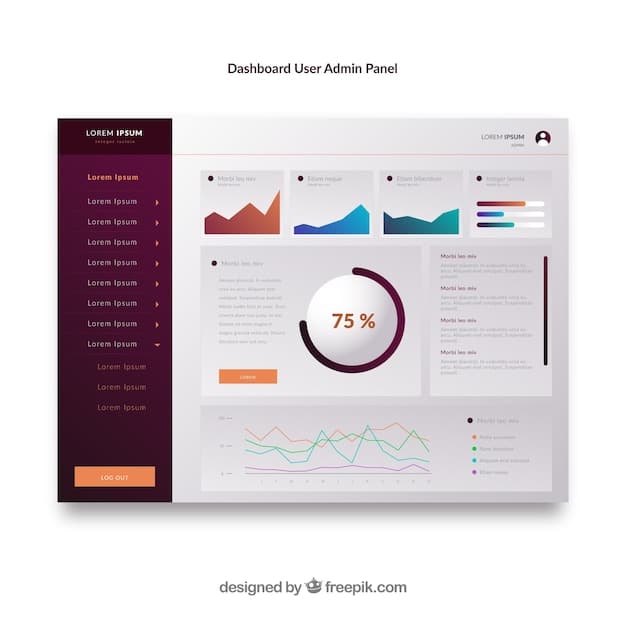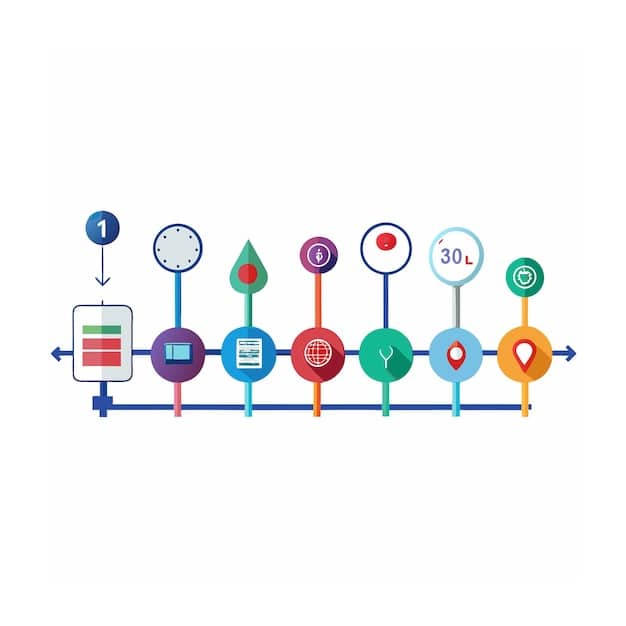The Future of Email Marketing: Personalization & Automation in 2025

The Future of Email Marketing: Personalization and Automation Strategies for 2025 will focus on leveraging AI-driven insights to craft hyper-personalized experiences, automate complex customer journeys, and enhance data privacy measures to build stronger, more valuable relationships with subscribers.
The landscape of email marketing is rapidly evolving. To stay ahead, marketers must embrace innovation. This article explores the future of email marketing: personalization and automation strategies for 2025, offering insights into how businesses can thrive in a competitive digital world.
Evolving Trends Shaping Email Marketing
Email marketing is far from obsolete; it’s transforming, becoming more sophisticated and targeted. Understanding the key trends driving this evolution is crucial. Let’s look into the factors reshaping email marketing in 2025.
AI-Powered Personalization
Artificial intelligence (AI) is revolutionizing personalization. AI algorithms analyze vast datasets to understand individual customer preferences and behaviors, enabling marketers to deliver hyper-personalized content.
Enhanced Automation
Automation is becoming more intelligent and adaptive. Advanced automation tools can trigger personalized email sequences based on real-time customer interactions, ensuring timely and relevant messaging.
- Predictive Analytics: Utilizing AI to predict customer behavior and tailor email content accordingly.
- Dynamic Content Optimization: Automatically adjusting email elements based on individual user data.
- Personalized Product Recommendations: Delivering product recommendations based on past purchases and browsing history.

The convergence of these trends signifies a shift towards more data-driven, customer-centric email marketing strategies. By embracing AI and advanced automation, marketers can create more meaningful and impactful email experiences.
Hyper-Personalization: The Key to Engagement
In 2025, generic email blasts will be a thing of the past. Hyper-personalization is the new standard, requiring marketers to understand each subscriber on an individual level. Let’s delve into how hyper-personalization can transform your email campaigns.
Data-Driven Insights
Leveraging data analytics to gain deeper insights into customer preferences and behaviors is essential. This includes analyzing purchase history, browsing behavior, and engagement metrics.
Dynamic Content
Dynamic content adapts in real-time based on user data, ensuring that each subscriber receives content tailored to their specific interests and needs.
- Personalized Subject Lines: Crafting subject lines that resonate with individual subscribers.
- Customized Email Content: Tailoring email body content based on user demographics and interests.
- Behavior-Based Segmentation: Segmenting subscribers based on their engagement with previous emails.
Hyper-personalization creates a sense of connection and relevance, increasing engagement and driving conversions. By delivering highly tailored content, marketers can build stronger relationships with their audience.
Automating Complex Customer Journeys
Automation is no longer just about sending triggered emails; it’s about orchestrating complex customer journeys that deliver value at every touchpoint. Discover how advanced automation can improve the customer experience.
Behavioral Triggers
Setting up behavioral triggers based on customer actions, such as website visits or abandoned carts, ensures timely and relevant engagement.
Multi-Channel Integration
Integrating email with other marketing channels, such as SMS and social media, creates a seamless and cohesive customer experience.
By automating these journeys, marketers can deliver consistent and personalized experiences that drive customer loyalty and advocacy. This approach ensures that customers receive the right message at the right time, enhancing their overall experience.

Leveraging AI for Enhanced Email Marketing
AI is becoming an indispensable tool for email marketers. It offers capabilities such as predicting customer behavior and optimizing campaign performance. Let’s explore the specific ways AI enhances email marketing strategies.
Predictive Analytics
AI-powered predictive analytics can forecast customer behavior, allowing marketers to tailor campaigns to maximize engagement. This includes predicting churn, identifying high-value customers, and anticipating purchase patterns.
Content Optimization
AI algorithms can optimize email content, subject lines, and send times to improve open rates and click-through rates. A/B testing powered by AI can quickly identify the most effective elements.
- Smart Segmentation: Automatically segmenting subscribers based on predictive behavior.
- Sentiment Analysis: Analyzing customer feedback to improve messaging.
- Personalized Send Times: Optimizing send times for individual subscribers based on their engagement patterns.
By leveraging AI, marketers can make data-driven decisions that enhance the effectiveness of their email campaigns, resulting in higher ROI and improved customer satisfaction.
Data Privacy and Security in Email Marketing
As data privacy regulations become more stringent, protecting customer data is paramount. Transparency and compliance are essential for building trust. Let’s examine the best practices for data privacy and security in email marketing.
Compliance with Regulations
Ensuring compliance with regulations such as GDPR and CCPA is crucial. This includes obtaining explicit consent, providing transparent data usage policies, and offering easy opt-out options.
Data Encryption
Implementing robust data encryption methods protects sensitive information from unauthorized access. This includes encrypting email content and securing databases.
Prioritizing data privacy and security builds trust and enhances brand reputation. Transparent communication and responsible data handling are essential for maintaining customer relationships and ensuring long-term success.
Measuring Success: Key Metrics and Analytics
Tracking the right metrics is essential for evaluating the effectiveness of email marketing campaigns. Understanding key performance indicators (KPIs) provides valuable insights. Here are the essential metrics to monitor in 2025.
Open Rates and Click-Through Rates
Monitoring open rates and click-through rates provides insights into the effectiveness of subject lines and email content. These metrics indicate how well your message resonates with subscribers.
Conversion Rates
Tracking conversion rates measures the success of your email campaigns in driving desired actions, such as purchases or sign-ups. This metric is a direct indicator of ROI.
- Customer Lifetime Value (CLTV): Assessing the long-term value of customers acquired through email marketing.
- Return on Investment (ROI): Calculating the profitability of email marketing campaigns.
- Engagement Metrics: Analyzing metrics such as time spent reading emails and social sharing.
By tracking these metrics, marketers can gain a comprehensive understanding of campaign performance and make data-driven optimizations to improve results.
| Key Aspect | Brief Description |
|---|---|
| 🤖 AI Personalization | Using AI to tailor email content to individual preferences. |
| 🚀 Automation | Automating email sequences based on real-time customer actions. |
| 🔒 Data Privacy | Ensuring compliance with regulations like GDPR and CCPA. |
| 📈 Key Metrics | Tracking open rates, CTR, and conversion rates for optimization. |
Frequently Asked Questions
▼
AI will analyze vast datasets to understand individual customer preferences and behaviors, enabling marketers to deliver hyper-personalized content that resonates with each subscriber.
▼
Email automation allows marketers to send timely and relevant messages based on customer actions, improving engagement, driving conversions, and building stronger relationships with subscribers.
▼
Ensure compliance with regulations like GDPR and CCPA by obtaining explicit consent, providing transparent data usage policies, offering easy opt-out options, and implementing robust data encryption methods.
▼
Track open rates, click-through rates, conversion rates, customer lifetime value (CLTV), and return on investment (ROI) to gain insights into campaign performance and make data-driven optimizations.
▼
Integrating email with other marketing channels, such as SMS and social media, creates a seamless and cohesive customer experience, ensuring customers receive the right message at the right time.
Conclusion
The future of email marketing is bright, driven by personalization, automation, and AI. By embracing these strategies, marketers can create more meaningful and effective campaigns that build stronger customer relationships and drive business growth.





